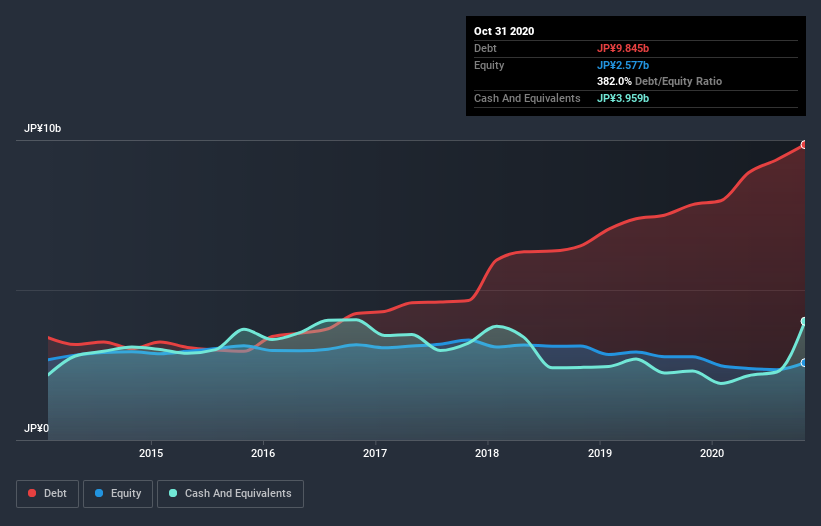- Japan
- /
- Healthcare Services
- /
- TSE:4355
LONG LIFE HOLDING (TYO:4355) Use Of Debt Could Be Considered Risky

Howard Marks put it nicely when he said that, rather than worrying about share price volatility, 'The possibility of permanent loss is the risk I worry about... and every practical investor I know worries about.' So it might be obvious that you need to consider debt, when you think about how risky any given stock is, because too much debt can sink a company. As with many other companies LONG LIFE HOLDING Co., Ltd. (TYO:4355) makes use of debt. But the more important question is: how much risk is that debt creating?
What Risk Does Debt Bring?
Debt assists a business until the business has trouble paying it off, either with new capital or with free cash flow. Ultimately, if the company can't fulfill its legal obligations to repay debt, shareholders could walk away with nothing. While that is not too common, we often do see indebted companies permanently diluting shareholders because lenders force them to raise capital at a distressed price. Of course, plenty of companies use debt to fund growth, without any negative consequences. When we think about a company's use of debt, we first look at cash and debt together.
View our latest analysis for LONG LIFE HOLDING
What Is LONG LIFE HOLDING's Net Debt?
You can click the graphic below for the historical numbers, but it shows that as of October 2020 LONG LIFE HOLDING had JP¥9.85b of debt, an increase on JP¥7.85b, over one year. On the flip side, it has JP¥3.96b in cash leading to net debt of about JP¥5.89b.

How Strong Is LONG LIFE HOLDING's Balance Sheet?
The latest balance sheet data shows that LONG LIFE HOLDING had liabilities of JP¥8.92b due within a year, and liabilities of JP¥8.18b falling due after that. Offsetting these obligations, it had cash of JP¥3.96b as well as receivables valued at JP¥1.46b due within 12 months. So its liabilities outweigh the sum of its cash and (near-term) receivables by JP¥11.7b.
The deficiency here weighs heavily on the JP¥2.50b company itself, as if a child were struggling under the weight of an enormous back-pack full of books, his sports gear, and a trumpet. So we'd watch its balance sheet closely, without a doubt. After all, LONG LIFE HOLDING would likely require a major re-capitalisation if it had to pay its creditors today.
We measure a company's debt load relative to its earnings power by looking at its net debt divided by its earnings before interest, tax, depreciation, and amortization (EBITDA) and by calculating how easily its earnings before interest and tax (EBIT) cover its interest expense (interest cover). Thus we consider debt relative to earnings both with and without depreciation and amortization expenses.
LONG LIFE HOLDING shareholders face the double whammy of a high net debt to EBITDA ratio (8.4), and fairly weak interest coverage, since EBIT is just 0.80 times the interest expense. This means we'd consider it to have a heavy debt load. Another concern for investors might be that LONG LIFE HOLDING's EBIT fell 10% in the last year. If that's the way things keep going handling the debt load will be like delivering hot coffees on a pogo stick. The balance sheet is clearly the area to focus on when you are analysing debt. But it is LONG LIFE HOLDING's earnings that will influence how the balance sheet holds up in the future. So if you're keen to discover more about its earnings, it might be worth checking out this graph of its long term earnings trend.
Finally, while the tax-man may adore accounting profits, lenders only accept cold hard cash. So it's worth checking how much of that EBIT is backed by free cash flow. Over the last three years, LONG LIFE HOLDING saw substantial negative free cash flow, in total. While investors are no doubt expecting a reversal of that situation in due course, it clearly does mean its use of debt is more risky.
Our View
On the face of it, LONG LIFE HOLDING's conversion of EBIT to free cash flow left us tentative about the stock, and its level of total liabilities was no more enticing than the one empty restaurant on the busiest night of the year. And furthermore, its net debt to EBITDA also fails to instill confidence. We should also note that Healthcare industry companies like LONG LIFE HOLDING commonly do use debt without problems. Considering all the factors previously mentioned, we think that LONG LIFE HOLDING really is carrying too much debt. To us, that makes the stock rather risky, like walking through a dog park with your eyes closed. But some investors may feel differently. When analysing debt levels, the balance sheet is the obvious place to start. But ultimately, every company can contain risks that exist outside of the balance sheet. For instance, we've identified 5 warning signs for LONG LIFE HOLDING (2 are concerning) you should be aware of.
At the end of the day, it's often better to focus on companies that are free from net debt. You can access our special list of such companies (all with a track record of profit growth). It's free.
If you decide to trade LONG LIFE HOLDING, use the lowest-cost* platform that is rated #1 Overall by Barron’s, Interactive Brokers. Trade stocks, options, futures, forex, bonds and funds on 135 markets, all from a single integrated account. Promoted
New: AI Stock Screener & Alerts
Our new AI Stock Screener scans the market every day to uncover opportunities.
• Dividend Powerhouses (3%+ Yield)
• Undervalued Small Caps with Insider Buying
• High growth Tech and AI Companies
Or build your own from over 50 metrics.
This article by Simply Wall St is general in nature. It does not constitute a recommendation to buy or sell any stock, and does not take account of your objectives, or your financial situation. We aim to bring you long-term focused analysis driven by fundamental data. Note that our analysis may not factor in the latest price-sensitive company announcements or qualitative material. Simply Wall St has no position in any stocks mentioned.
*Interactive Brokers Rated Lowest Cost Broker by StockBrokers.com Annual Online Review 2020
Have feedback on this article? Concerned about the content? Get in touch with us directly. Alternatively, email editorial-team (at) simplywallst.com.
About TSE:4355
LONG LIFE HOLDING
LONG LIFE HOLDING Co., Ltd., together with its subsidiaries, engages in the nursing home business primarily in Japan.
Slightly overvalued with questionable track record.
Market Insights
Community Narratives




